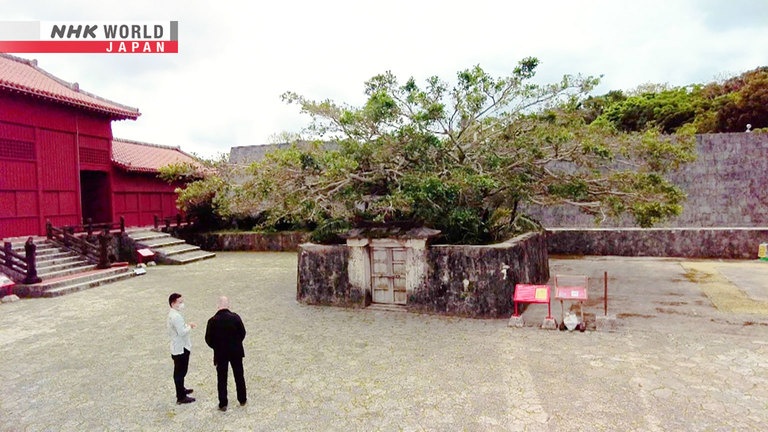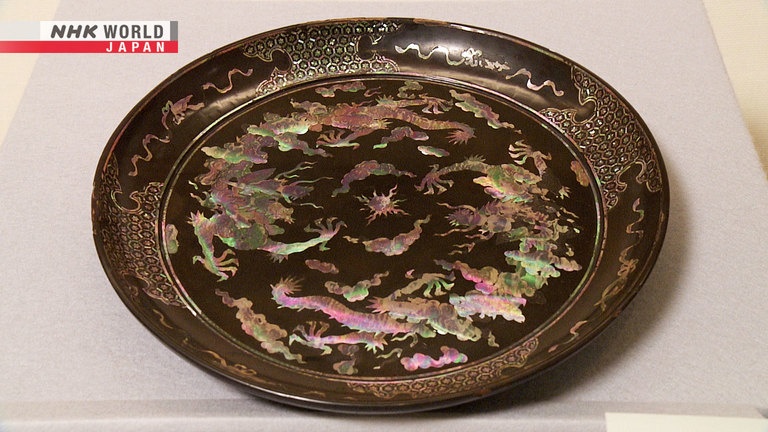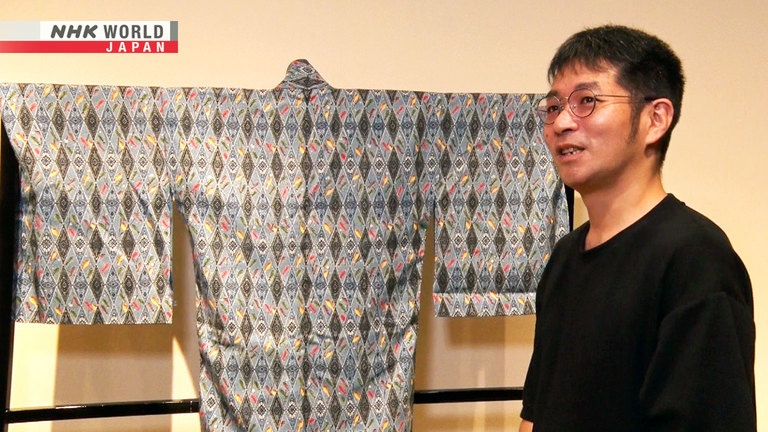Okinawa: The Ryukyu Kingdom
*First broadcast on July 14, 2022.
Okinawa Prefecture is a group of subtropical islands in the far south of Japan. It was previously a prosperous maritime trading state called the Ryukyu Kingdom. In the first of 2 episodes about Okinawa, we discover how the Ryukyu Kingdom maintained an independent identity for 450 years. Our guest, historian Uezato Takashi, talks about the clever diplomatic strategies Ryukyu used with its larger neighbors, China and Japan. And we learn how that contributed to an eclectic and original outlook.



Transcript
Hello, and welcome to Japanology Plus.
I'm Peter Barakan.
This is the first of two episodes about
Japan's southernmost prefecture, Okinawa.
Today we'll be talking
about the Ryukyu Kingdom,
which was how Okinawa was known
before it became part of Japan.
The Ryukyu Kingdom existed as an
independent country for about 450 years,
and today I'll be visiting Shuri Castle,
which was its political
and cultural center,
and which you can see up
on top of a hill behind me there.
For 450 years,
the Ryukyu Kingdom was
an independent political entity
in the region between China and Japan.
The kingdom emerged in the 15th century.
It established diplomatic
relations with China,
and prospered by trading with
Japan and nations in southeast Asia.
An elaborate court culture took shape,
and the Ryukyu Kingdom
made a name for itself.
Shuri Castle has long been a prominent
symbol of Ryukyu prosperity.
Good morning.
Hello.
Nice to meet you.
Nice to meet you too.
Our guest, Uezato Takashi, is a historian
with a detailed understanding
of the castle's architecture.
This is Shureimon, a decorative gate
at the entrance to Shuri Castle.
It's built in a distinctive Chinese style.
This design is rarely seen
in Japanese castles.
The Ryukyu Kingdom had diplomatic
relations with Chinese dynasties.
That was a major influence.
A sign on the gate says,
“a country that upholds propriety.”
This was intended to
convey to Chinese envoys
a sense of the kingdom's noble standards.
Here's another connection to China.
This is “Zuisenmon,” which translates as
“auspicious spring gate.”
It's named after a nearby spring.
There, you'll find this dragon carving
that was a gift from the Chinese emperor
in the 16th century.
The imperial emissary praised
the quality of the water.
Other features of the castle
have an authentic Ryukyu appeal.
The walls have an undulating appearance
that is very unlike the straight walls of
castles elsewhere in Japan.
It looks beautiful.
We believe that's one reason why
this shape was chosen.
Another reason is its defensive merit.
You can repel enemies approaching
from many different directions.
That was a key factor, too.
Here's another Ryukyu feature.
It's an “utaki;”
a sacred space where people pray.
The utaki at Shuri Castle
is especially important.
According to Ryukyu legend,
it was built by divine powers.
Most castles elsewhere in Japan
don't have a dedicated place of prayer,
so this is a characteristic
of Ryukyu culture.
The main building of the complex, the
Seiden, once stood in this central area.
But in 2019,
it was destroyed in a devastating fire,
along with other buildings.
People were incredibly shocked,
both in Okinawa, and elsewhere.
This is what the central
building looked like.
The architecture was influenced
by Chinese palaces,
but also incorporated aspects of
Japanese temples and shrines.
The curved roof at the front, for example,
is common in Japanese architecture.
The buildings on either side
hosted visitors from Japan and China.
The building to the south,
which featured natural wood and
tatami flooring, was inspired by Japan.
The building to the north was bright red,
a Chinese influence.
The Ryukyu Kingdom
managed to stay independent,
despite being sandwiched
between China and Japan.
Shuri Castle reflected
that diplomatic balancing act.
In Shuri Castle you see the influence of
both Japan and China.
What kind of influence from
China do you see in daily life?
Perhaps not so much now, but in the past.
Well, something that
you can still see in Okinawa today
is distinctively shaped graves.
They're curved, like a turtle's shell.
With a big roof.
Yes.
That style originated
in Fujian Province, in China.
It is said that this style came
from China to Okinawa.
OK, I've never been to that part of China.
But when you come to Okinawa,
immediately, those things...you see them,
and you don't forget them.
And I didn't know what they were at first.
I had no idea that they were graves.
Here's something else:
you often see stone tablets placed
at T-junctions and so on.
They're protective charms.
All sorts of evil spirits
and supernatural beings
were thought to be wandering around,
and the tablets warded them off.
They're found all over the islands.
Even now?
Yes.
And do you see the same kind of
social influences from Japan as well?
One thing that comes to mind is religion.
Many centuries ago, Buddhism
and Shinto arrived from Japan,
and became established here.
Zen Buddhism, in particular,
came over from Japan,
and became the foundation
for Buddhism in Okinawa.
There's also writing.
Official Ryukyu documents were written
using characters from Japan.
Official documents were
written in hiragana,
one of the writing systems
used in Japanese.
In Japan, similar texts in those days
were written in classical Chinese.
The ruling classes used
hiragana in administrative documents.
Townspeople also adopted hiragana.
It's thought that the characters were
brought to Ryukyu by Japanese priests.
They brought hiragana over,
and it became established here.
It's interesting that there's
so much influence from both countries.
Was there always a sort of atmosphere
of welcoming people from outside?
Yes;
leaders of the Ryukyu Kingdom absorbed
culture from their larger neighbors,
and they did so very deliberately.
That approach gained them access to
things that weren't available
in their small group of islands.
That was how they survived,
and they saw it as very important.
However, they didn't simply absorb
everything that came their way.
They selected certain aspects,
and the result was an eclectic
and original Ryukyu outlook
that was neither Chinese nor Japanese.
It was something new.
One tool that the Ryukyu Kingdom used to
preserve its independence was diplomacy.
And they applied a clever technique.
The nation gained an advantage
in diplomacy and trade
by employing Chinese settlers
to prepare diplomatic documents,
or to work as interpreters and navigators.
However, at the beginning
of the 17th century,
an army of 3,000 Japanese
conquered the islands.
Ryukyu became subject to
Japanese authority.
Nevertheless,
the Ryukyu Kingdom was allowed to
maintain its own relations with China,
to whom it had previously sworn loyalty.
The kingdom ended up
serving both China and Japan.
But it also carved out a clear identity,
with arts and crafts playing a key role.
This is a museum in the city of Urasoe.
It has a display of Ryukyu lacquerware.
Items like this were
given in tribute to members
of the Japanese or Chinese ruling classes.
Hello. Nice to meet you.
Our guide is the facility's director,
Miyazato Masako.
Look at this one. It's dazzling.
Whoa,
that's beautiful. Yes.
This tray was made using
a “raden” technique,
where iridescent seashell is cut and then
applied, to create a pattern or design.
This was presented to the Chinese emperor.
The emperor's symbol was
a five-clawed dragon.
You can see that here.
The tray was decorated with
that dragon design, in his honor.
The inlay uses the shell
of a local marine snail.
When viewed from different
angles the colors change,
and these rainbow hues came to be prized.
The Ryukyu Kingdom was small.
Nevertheless, it had a rich culture,
and skilled artisans.
The act of
giving trays like this to the emperor
was an expression of cultural pride.
Influential Japanese, meanwhile,
loved these stylish cases.
The raden here presents
a Chinese-style landscape.
It's another example of
the Ryukyu Kingdom's love
of combining different cultures.
They sent many of these cases to Japan,
as gifts for the shogun and feudal lords.
At the time, Japan's elite were influenced
by Confucian thought,
and products in a Chinese style
were high status items.
Lacquerware with
a Chinese look was prized.
17th to 18th centuries.
That must have been very, very cool,
I think, back in those days.
The Kingdom made lacquerware
for both China and Japan.
But they made it differently
to suit each recipient.
They took the values and tastes
of each country into account
in the design process.
Generous gifts of exquisite
lacquerware made it easier
for the Ryukyu Kingdom to develop strong
relations with both China and Japan.
Another common gift to China was fabric
dyed using a technique called “bingata.”
In the Ryukyu islands,
bingata garments were luxury items,
worn only by royalty and aristocrats.
This workshop is one of the places
where that fabric was made.
It has been operating for over 300 years.
Hello. Nice to meet you.
Nice to meet you too!
Shiroma Azuki is in charge of production.
She presents some of their work.
This classic pattern
has existed for centuries.
The yellow is very striking.
It's not a color you see
very much in kimono.
Even in Okinawa's strong sunlight,
it stands out.
It makes an impact.
Bingata is known for vivid pigments
and bold color combinations.
Another distinctive feature
is evident in the design motifs.
Can you see this?
It's a mythical creature:
the Chinese phoenix.
This motif has roots in China.
And there, we have chrysanthemums,
which are representative of Japan.
So the kimono is a real mixture.
Bingata takes elements
from different cultures.
One element from here,
mixed with an element from there.
A Chinese phoenix...
and Japanese chrysanthemums.
This is another example of
Okinawa's openness to cultural influence.
Bingata garments weren't
just presented as gifts.
They were a feature of
Ryukyu diplomatic protocol.
For example,
here's a performance by Ryukyu envoys
dispatched to Edo, the capital of Japan.
The Ryukyu Kingdom sent
a delegation like this
every time a new shogun came to power.
Trumpets, gongs and other rare instruments
would entertain onlookers along the way.
Then in Edo,
members of the delegation would dance for
the shogun in colorful bingata garments.
Similarly, when envoys from
China and Japan visited Shuri Castle,
they were welcomed with performances
by local dancers wearing bingata kimono.
Occasions like these were
an opportunity to stress
that the Ryukyu Kingdom was
a separate nation with its own identity.
An open outlook and artistic originality
were thus key elements
in the Ryukyu Kingdom's battle
to stay independent.
When it comes to lacquerware, bingata,
and other Ryukyu handicrafts,
a notable factor is the makers.
Artists will often cultivate
a unique style.
They seek out their own path.
But that didn't happen here.
Artists were raised systematically
by the state, in a highly strategic way.
Within Shuri Castle was
a special lacquerware department.
They picked designs,
and decided on the production output.
They placed orders with civilian artisans,
and awaited delivery.
They used those products
as gifts for foreign nations.
So one facet of arts and crafts in Ryukyu
was close government supervision.
Another original aspect
of the culture is awamori.
Awamori dates back to
around the 15th century.
It is a distilled spirit made using rice,
and black koji mold.
Awamori is another example of something
that didn't develop independently.
It was carefully managed
and cultivated by the government.
Permission to make
it was given to specific distillers,
along with the necessary
ingredients and equipment.
They were instructed to
make a certain amount,
which they then delivered to Shuri Castle.
That awamori was served
at diplomatic events.
Do we know from historical records
whether people enjoyed it or not?
Well, when a US envoy
—Commodore Matthew Perry—
visited Shuri Castle in the 19th century,
he was served awamori,
and records show he really liked it.
Haha!
Many aspects of local culture,
including the art and awamori
we've been talking about,
were carefully developed
by the Ryukyu government in Shuri Castle.
Much of what we consider today
to be traditional Ryukyu culture
has its roots in that time.
So why did the Ryukyu Kingdom
take that course?
Well, it was a small country.
It worked hard on diplomacy
and cultural development
because they opened a path to survival
in the presence of two bigger neighbors.
But this approach didn't involve
military power or economic strength.
And it established the culture
that we can still see today.
The second half of the 19th century
brought a period of real hardship.
Japan had a new government
that unilaterally declared the Ryukyu
islands part of Japanese territory,
thereby creating “Okinawa Prefecture”.
In 1879,
Japan sent armed forces to Shuri Castle to
make sure that the decision was accepted.
The king put up no resistance.
And so, after 450 years,
the Ryukyu Kingdom came to an end.
Then, in 1945, in the closing stages
of the Second World War,
US and Japanese forces clashed in Okinawa,
with devastating consequences.
Shuri Castle, and the Ryukyu culture
it represented, were largely destroyed.
When the war ended,
Okinawa fell under US control,
and its people began
the slow process of rebuilding.
One of the many local businesses
that suffered terribly in the war
was a bingata maker with
a history of 300 years.
With its workspace and tools destroyed,
the company was on the brink of closure.
But the workers didn't give up.
Shiroma Eiichi comes from
a long line of bingata artisans.
He grew up hearing stories of how his
grandfather got the business going again.
These are the things
he used after the war.
They're made from bullet casings
and items discarded by the US military.
This tool is called a tsutsugaki.
You use it to apply paste to all
the places that will stay white.
You put paste in here,
then draw the outlines and so on.
The tip was made using a bullet casing.
Like this.
This was just after the end of the war.
At that time, spent bullets
were everywhere.
People salvaged anything
that might be useful for dyeing,
and used those materials to make tools.
This was made from a vinyl record.
It was used to apply paste.
Records like this had been discarded,
so people made use of them.
Although the workshop had managed to
resume the production of bingata fabrics,
there were few buyers.
So instead, they made money by
selling bingata postcards to US soldiers.
It was a novel approach
to conserving traditional techniques.
Although nowadays we mainly make kimono,
back then there was no demand for them.
So they used traditional techniques
to make something that would sell.
Products people might buy.
Once bingata production
was up and running again,
the workshop launched a new trend
that showcased aspects
of Okinawa's natural beauty.
This design, featuring fish and crabs,
evokes the ocean around Okinawa.
Ryukyu designs had previously
incorporated various foreign elements.
But after the Second World War,
local motifs became increasingly common.
This is one of Shiroma's recent designs.
It shows a school of local fish.
I gave them many different colors.
Fish actually slightly change color when
they're surprised, when they're angry,
or when they're not active.
I exaggerated that in the design.
In any case, Okinawan people like
capturing the essence of things.
We don't just make a copy
of a motif from somewhere else.
Bearing that in mind,
I want to maintain an Okinawan identity,
and uphold Okinawan perspectives,
in order to create something original.
Something that's truly us.
Okinawa's artisans used
anything they could lay hands on
to keep their craft going.
This resourceful approach helped to
preserve a cultural tradition.
In Okinawa in the present day, there's
a word that's often used: champuru.
Which is like a mixture
of different things.
So does that go back all the way
to the old days when
they were being influenced by
Japan and China and other places?
Yes, for me, champuru is
the very essence of Ryukyu culture—
a sense of eclecticism and originality.
When you look back through history,
you see that the Ryukyu Kingdom was under
constant pressure from outside forces
that it couldn't beat.
But rather than trying to win,
they decided to simply avoid losing.
That theme runs right through
the history of the Ryukyu Kingdom.
In modern times, the global balance
of power is increasingly uneven.
Many other nations may want to
seek ways to avoid conflict.
And I think that Okinawa and the Ryukyu
Kingdom offer hints on how to do that.
That's all really interesting.
Of course this all happened
quite a long time ago.
I wonder how aware the people of Okinawa
now are of their own history?
The people of these islands have been
through an awful lot.
The Second World War was devastating,
and it marked an end
to many aspects of local culture.
But recently, we're starting to carve out
a new culture, a new identity
that draws on the long history of
the Ryukyu Kingdom, and Okinawa.
Although people here have long been
open to outside influences,
they still see themselves as themselves.
They have a strong, distinct identity.
And these days, many people
in Okinawa embrace that identity.
I see the culture itself as heritage
that has been passed down
through the centuries,
carrying traces of the past.
This has all been really fascinating,
thank you very much.
Thank you for having me.
Next time we'll look at the fire in 2019
that ravaged Shuri Castle,
and the developments since then.